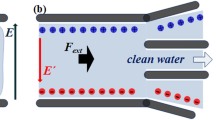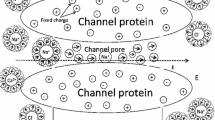Abstract
Today, the equilibrium behavior of ions in solution may be predicted with some confidence, essentially because rapid ionic diffusion over small distances ensures homogeneity throughout the solution. Equilibrium concepts such as ionic strength and pH apply. However, when attempting to understand the behavior of ions passing rapidly through narrow pores such as ion channels, no such equilibrium state may be assumed. The passing solution may have been in equilibrium with conditions at the mouth of the pore but will not be in equilibrium with charged molecules on the pore wall. In addition, the water in narrow pores will be partially ordered by contact with the pore walls and will not behave like bulk water.
To illustrate this difference, a simple equilibrium calculation of the ion concentrations near a plastic sheet penetrated by narrow pores and containing in its surface partially ionized carboxyl groups is shown to be in good agreement with experiment. However, to predict the non-equilibrium behavior within the narrow pores is much more difficult. To illustrate the difficulty, a Monte Carlo computer model is described which attempts to predict the rapid switching of ion current observed experimentally with these narrow pores.
Similar content being viewed by others
REFERENCES
Barrer, R. M. and Rees, L. V. C. (1960) Self diffusion of alkali metal ions in analcite. Trans. Faraday Soc. 56:709–721.
Barrer, R. M., Bartholomew, R. F., and Rees, L. V. C. (1963) Self and exchange diffusion of ions in chabazites. J. Phys. Chem. Solids 242:51–62.
Berry, R. and Edmonds, D. T. (1993) Correlated ion flux through parallel pores: application to channel subconductance states. J. Mem. Biol. 133:77–84.
Bleaney and Bleaney (1989) Electricity and Magnetism. 3rd. Edn. Oxford: Oxford University Press.
Cooke, A. H., Edmonds, D. T., Finn, C. B. P., and Wolf, W. P. (1962) Demagnetization experiments on substances with large magnetic dipolar interactions. J. Phys. Soc. Japan 17(B1):481–486.
Doyle, D. A., et al. (1998) The structure of the potassium channel: molecular basis of K+ conduction and selectivity. Science 280:69–77.
Du, Q., Freysz, E., and Shen, Y. R. (1994) Surface vibrational studies of hydrogen bonding and hydrophobicity. Science 264:826–828.
Edmonds, D. T. (1979) A reversible electrostatic channel for ion transport. Chem. Phys. Lett. 65:429–433.
Edmonds, D. T. (1980) Membrane ion channels and ionic hydration energies. Proc. R. Soc. Lond. B211:61–62.
Edmonds, D. T. (1981) A physicist's view of membrane ion channels. TIBS 6:92–94.
Edmonds, D. T. (1984) The ordered water model of membrane ion channels. In Biological Membranes, vol. 5 (D. Chapman, ed.), London: Academic Press, pp. 349–387.
Edmonds, D. T. and Berry, R. (1991) The proton ladder, a static mechanism for ion/proton coports and counterports. Eur. Biophys. J. 20:241–245.
Edmonds, D. T. (1994) Enhanced ionic interaction in narrow pores and ion pair formation. Eur. Biophys. J. 23:133–138.
Enderby, J. E. and Neilson, G. W. (1979) X-ray and neutron scattering by aqueous solutions of electrolytes. In Water a Comprehensive Treatise. (F. Franks, ed.), London: Plenum Press, pp 1–46.
Hille, B. (1992) Ionic Channels in Excitable Membranes, 2nd Edn. Sunderland, Massachusetts: Sinauer Associates.
Israelachvli, I. and Pashley, R. (1982) The hydrophobic interaction is long range, decaying exponentially with distance. Nature 300:341–342.
Israelachvili, J. (1992) Intermolecular and Surface Forces, 2nd Edn. London: Academic Press.
Kim, K. S., Nguyen, P. K., Swaminathan, P. K., and Clement, E. (1985) Na+ and K+ transport through a solvated Gramicidin A transmembrane channel: Molecular dynamics studies using parallel processors. J. Phys. Chem. 89:2870–2876.
Korchev, Y. E. et al. (1997) A novel explanation for fluctuations of ion current through narrow pores. FASB 11:600–608.
Lee, C. Y. and McCammon, J. A. (1984) The structure of liquid water at an extended hydrophobic surface. J. Chem. Phys. 80:4448–4455.
Lev, A. A., Korchev, Y. E., Rostovtseva, T. A., Bashford, C. L., Edmonds, D. T., and Pasternak, C. A. (1993) Rapid switching of ion current in narrow pores: implications for biological ion channels. Proc. R. Soc. Lond. B252:187–192.
Mackay, D. H. J., Berens, P. H., and Wilson, K. R. (1984) Structure and dynamics of ion transport through Gramicidin A. Biophys. J. 46:229–248.
Parsegian, A. (1969) Energy of an ion crossing a low dielectric membrane: solutions of four relevant problems. Nature 221:844–846.
Pasternak, C. A. et al. (1995) Nuclear track-etched filters as model pores for biological membranes. Radiation Meas. 25:675–683.
Rostovtseva, T. K. et al. (1996) Diffusion through narrow pores: Movement of ions, water and nonelectrolytes through track-etched PETP membranes. J. Mem. Biol. 151:29–43.
Sachs, F. and Quin, F. (1993) Gated, ion-selective channels observed with patch pipettes in the absence of membranes: Novel properties of a gigaseal. Biophys. J. 65:1101–1107.
Toney, M. F. et al. (1994) Voltage-dependent ordering of water molecules at an electrode-electrolyte interface. Nature 368:444–446.
Warshel, A. and Russell, S. T. (1984) Electrostatic interactions in biological systems and in solution. Q. Rev. Biophys. 17:283–422.
Zhu, S. B. and Robinson, G. W. (1991) Structure and dynamics of liquid water between plates. J. Chem. Phys. 42(2):1403–1410.
Author information
Authors and Affiliations
Rights and permissions
About this article
Cite this article
Edmonds, D.T. The Behaviour of Ions in Narrow Water-Filled Pores. Biosci Rep 18, 313–327 (1998). https://doi.org/10.1023/A:1020209332415
Issue Date:
DOI: https://doi.org/10.1023/A:1020209332415




